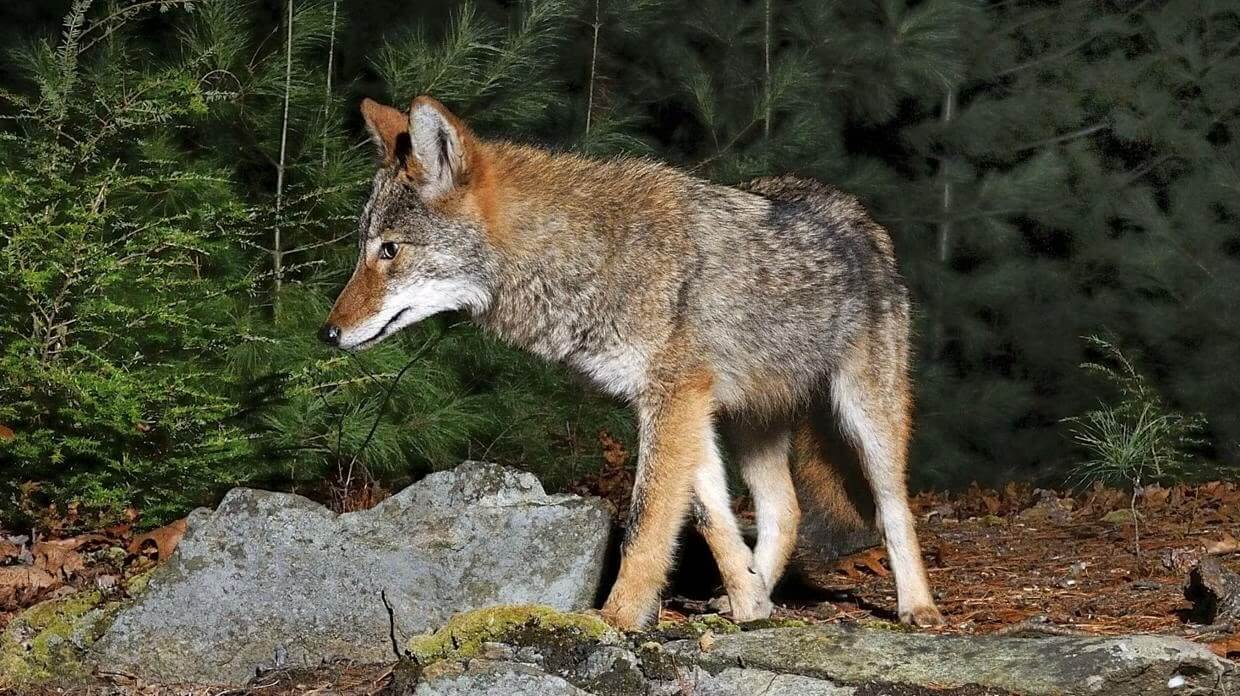By Wilson Kerr
Coyotes are out and about, looking for love! Late winter is mating season, and their amorous pursuits mean they are seen more often. For some, this can be alarming.
This month, I hope to dispel coyote-related fears, but first, we need to talk about… wolves.
You see, prior to European settlement, New England was covered in old-growth forests, and large apex predators were common. For tens of thousands of years, timber wolves kept deer and moose populations strong by testing the herds for the easiest kill. Bears and mountain lions were here, too.
Almost upon arrival, settlers embarked on a 200-year shooting, poisoning and trapping campaign that made wolves extinct in New England by 1900 (along with many other species). Widespread deforestation also radically changed the landscape.
But nature detests a void, and in the 1950s, western coyotes started moving east, filling the ecological gap left by the wolves. With most other predators gone and the forests growing back, they found abundant prey and interbred with some of the last wolves along the way, creating a new, larger subspecies — the Eastern Coyote. Their dash of leftover wolf genetics is why some call them “coywolves.”
Today, they range across New England and are omnivores, eating a variety of small mammals, berries, amphibians, and even insects. They hunt deer, but usually just fawns and injured adults. Coyotes play an increasingly important (and helpful) role in reducing Lyme disease, as they eat a LOT of mice – a primary vector for ticks.
Know your coyotes
Heartier than their plains-dwelling western cousins, Eastern Coyotes weigh 30-50 pounds as adults. They look like medium-sized dogs, with a longer snout, pointy ears, and a bushy tail that points down when they run (a giveaway). They are smart, adaptable and highly social animals that communicate via howls and yips. Their Latin name is Canis latrans, which means “barking dog.”
In late winter, they breed, dig dens (usually in thickets of brush to hide the site), and have four to seven pups in the spring. Pups are weaned after nine months, and the number of pups born is tied to the density of coyotes in an area.
Eastern Coyotes live six to nine years, typically hunt alone or in pairs, and rarely group with other coyotes. Families are led by an alpha male or female who scent-mark a home territory of five to 25 miles. Most are light brown/grey, but some are very dark. They have adapted well here, with an estimated 10,000 in Massachusetts today.
A rightfully wary species
So, with so many around, why don’t we see them more often? This is because they become largely nocturnal in proximity to people, meaning most are active only at night. And for good reason — an estimated 400,000 are still shot and trapped in the U.S. annually.
They are rightfully wary of people and will almost always run in the opposite direction. While it can be surprising to see one, statistically speaking, people have very little to fear from coyotes. Attacks are extremely rare. That said, they are opportunistic hunters and leaving a chicken coop unlatched or letting your cat roam is unwise, especially at night. Common sense usually mitigates conflict.
In my view, having these beautiful animals here should be celebrated as a sign of an ecosystem that has adjusted and adapted to have all its parts, predators included. So, if you hear coyotes howling at night, I hope you will listen with different ears. Maybe even consider the sound a reminder of nature’s resilience and adaptation rather than something to be fearful of.
Until next month, keep your cats safely inside, celebrate ALL the sights and sounds of the wilderness we have left, and spend more …Time Outdoors!
Wilson Kerr lives in Concord and is an avid outdoorsman and amateur naturalist. This monthly column is written to help grow awareness of the wonders of nature. In this increasingly technology-packed world, it is important to stop and take in the beauty of our area and the animals that inhabit it. The author hopes this column will be read by families and used as a teaching tool and that you will spend more … Time Outdoors.






